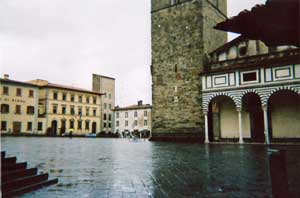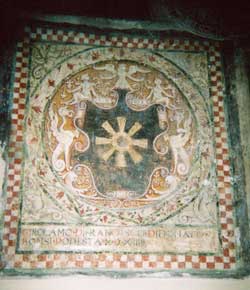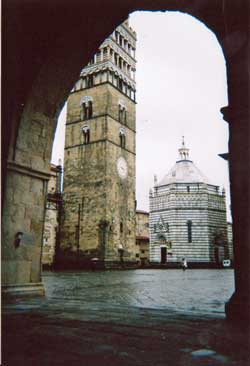Pistoia tourist information
Pistoia is a little-known delight. It lies in the tourist heart of Tuscany, a stone’s throw from Florence, Lucca and Siena, but tends to get missed out by travellers. This isn’t completely surprising. The town is less grand than Florence, less ancient than Siena and less complete than Lucca, and its name doesn’t perhaps sound as pretty. Yet Pistoia is a gem. All the ingredients of an old Tuscan city are there – old walls, striped churches, frescoes, medieval watchtowers, arcaded piazzas – packed into a rather small centre.
Getting to Pistoia
Pistoia lies just off the autostrada between Pisa and Florence and is therefore very easily reached by car. The drive from Pisa airport is only 45 miles (70km) and from Florence only 25 miles (40km).
The town is also easy to reach by public transport. The main bus route from Pisa Airport to Florence passes further south, through Empoli, so the best approach is by rail: trains stop at Pistoia on the Pisa-to-Florence line through Lucca. From Lucca the service is particularly good, with trains at least every hour and a journey of only 40 minutes or so. Railway enthusiasts will appreciate, just as the train draws into Pistoia station, a collection of old steam locomotives parked on sidings to the left. To reach the old town from the railway station, march straight ahead for about ten minutes as far as Piazza Gavinana. Here you are at the corner of everything: enter the borgo by walking on and turning right, or by turning immediately right and then left.
There is also a bus service to Pistoia from Florence, run by Blubus, who also operate buses to the surrounding small towns.

History
Pistoia was a smallish Roman town, notable mainly for a nearby battle in which Cicero’s great enemy the conspirator Catiline died an outcast and rebel. It flourished in the Middle Ages, getting itself recognised as a pilgrimage site for the cult of Saint James and establishing a form of republican self-government, like several other Tuscan cities. Later rule by Lucca and Florence seems to have done the place no lasting damage. Pistoia was well known for its crafts, and has some claim to the origin of pistol, originally meaning a small weapon. The city fared less well during the tumults of the 19th century and could be described as rather a backwater today, but something of the old colour still remains. There’s a medieval-style palio called the Giostra dell’Orso (including processions and a horseback tournament between rival neighbourhoods) in the main piazza on 25th July, while several villages once under the aegis of Pistoia stage their own historical events on other dates in the summer.
Tourist sights of Pistoia
The centro storico (historic centre) as a whole claims top spot. Barely half the size of Lucca, it still manages to deliver ‘the full monty’, and Pistoia would attract similar attention to Lucca were it walled as neatly as Lucca and possessed a comparably serene grid-pattern. Anyone who finds Florence too much and Siena too self-conscious should pay a short visit.
The information office in the Piazza del Duomo – you can’t miss this big square – has everything you need to begin a tour of the tourist sights. It occupies a corner of the former bishop’s palace, so remember to look up at its lovely ceiling while there. Among other things, they can provide a map with numbered highlights as well as a very good fold-out leaflet (‘Pistoia, City of Art’) with just enough detail on what to see as well as on events and Pistoia’s past.
If you have both the interest and the stamina, there’s sufficient to keep you busy in the town centre for two full days. Most of the accredited sights have information boards outside in English and Italian and there are bars and restaurants in which to take a break from sightseeing. Our own choice of programme, in no particular order but enough to fill one full day, is as follows.
The surprisingly spacious Piazza del Duomo and the smaller Piazza della Sala are comparable to anything elsewhere, each of them (like the best of Italian squares) showing off buildings which differ wildly in both style and size: no ‘harmonious balance’ here! The Duomo (Cattedrale di San Zeno) itself is very dark inside yet worth visiting for one treasure alone – a silver altar covered in a fine relief of biblical stories, which is, almost unbelievably, six centuries old.
The Church of San Giovanni Fuorcivitas, sideways on to the road, has a striking exterior of banded dark green and white marble. The narrow windows are set high, probably for defence, so that the interior is, again, dark. However, one can dimly perceive some early frescoes and a 13th-century pulpit. A building next door, once ancillary to this old church, is now partly occupied by a restaurant.
The Basilica of the Madonna dell’Umiltà is another important church, less easy to track down this time as it stands away from the centre. You might recognise its dome from a distance, however: it was designed by Florentine artist/architect/historian Vasari and is very reminiscent of the Duomo in Florence.
Pistoia’s town hall (Palazzo Comunale) is as deeply significant as the churches. It dates from the beginning of Pistoia’s short but proud period as an independent republic and contains a museum with a not-too-massive collection of Pistoian art over several centuries; but look out also for the remains of frescoes on the walls of the rooms themselves. Nearby stands the Magistrates’ Palace, whose courtyard is festooned with frescoes and which still has its three rows of benches and the atmosphere of a High Court.
The front of the Ospedale del Ceppo, an old hospital which is still a medical building, is adorned with brightly-coloured terracotta reliefs which resemble glazed pottery. These are characteristic works by the Della Robbia family workshop. They may not be to everyone’s taste, but the gracefully arcaded loggia itself should be.

Two additional attractions in the Piazza del Duomo, which can be visited for a small fee when open (morning and afternoon but not Mondays), are the mathematically simple baptistry (medieval) and the contrastingly florid bell tower.
Pistoia’s town walls were rebuilt further out as the town expanded. Their earlier lines can be determined mainly from the street pattern of the centro storico, Via Cavour and Piazza Savinana, for example, marking a southern limit. Their final extent is very clear indeed. A long stretch complete with corner bastion, suiting the age of cannons, can be followed for example at the grassy Piazza della Resistenza, north-east of the station. They’re credited to the 16th-century Medici dukes but look better preserved, as if made ready again for the upheavals of the 19th.
Events
As well as its spectacular medieval festival on 25th July, Pistoia lays on a traditions and literature event in the spring and a long-established music festival every July. This has a strong blues side, which has succeeded in attracting world-class names. Up-to-date details of events can be found on the tourist board’s website (see links panel on the right).
Words and photographs by ARH
Pistoia accommodation
Good places to stay in Pistoia include the comfortable and modern four-star Villa Cappugi which is in a quiet area outside town (suitable for drivers) and has a swimming pool. For a more central option, possibilities include Hotel Patria, a four-star with comfortable modern rooms or the Locanda San Marco, a popular B&B.
